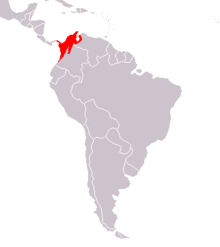Lesser capybara
| Lesser capybara | |
|---|---|

| |
| Scientific classification | |
| Domain: | Eukaryota |
| Kingdom: | Animalia |
| Phylum: | Chordata |
| Class: | Mammalia |
| Order: | Rodentia |
| Family: | Caviidae |
| Genus: | Hydrochoerus |
| Species: | H. isthmius
|
| Binomial name | |
| Hydrochoerus isthmius Goldman, 1912
| |

| |
| Lesser capybara range | |
The lesser capybara (Hydrochoerus isthmius)[2] is a large semi-aquatic rodent found in South America that has vast similarities, yet subtle differences, with the common Capybara (Hydrochoerus hydrochaeris), the largest species of rodent in the world.[3]

Habitat
[edit]The lesser capybara mainly inhabits areas close to water such as marshes, ponds, and lagoon habitats as these places offer water, which is essential for these capybaras to fulfil their niches' of maintain body temperature homeostasis, provide suitable food, hide from predators, and mate. They were first observed in Pacific river valleys in Panama as early as 1912 as a subspecies of the common capybara. However, after thorough studies on the anatomy and genealogy of them, the lesser capybara was classified as its own species some time in the 1980s.[4] Currently, this species has expanded its range to parts of Eastern Panama and Western Colombia and Venezuela, just west of the Andes Mountains. The lesser capybara constitutes the northernmost population of any capybara species.[3]
Diet
[edit]Lesser capybaras are herbivores that mainly graze on grasses and other aquatic plants. However, during dry seasons when their main source of food is depleted, the lesser capybaras will tend to feed on reeds, grains, melons, and squash. On average, an adult will eat 6-8 lbs of this food per day.[5] Although not a main part of their diet, lesser capybaras will also eventually ingest their own feces to gain bacteria that benefits them in breaking down thick fibers eaten.[5]
Physical description
[edit]Just like other capybaras, the lesser subspecies is characterized by short, brown-hair, with blunt snouts, four short legs (front legs are smaller than hind), partially webbed feet, small eyes and ears situated high on their head, and a very tiny tail.[6] Compared to other Capybaras, the lesser subspecies are generally smaller in size, with adults growing up to 3 ft in length, weighing up to 62 lbs, and having a darker brown coat.[4]

Adaptations
[edit]As animals that are considered prey for many animals, the species is very wary of predators and likes to travel in groups of about 20 cavies.[7] As a result, the capybaras have adapted to be excellent swimmers and dive regularly in water to avoid predators such as jaguars and anacondas.[6] Having eyes and ears placed high on their heads, the capybaras can see these predators while in the waters.[8] Furthermore, being immersed in water for long periods of time helps the capybaras regulate their body temperature by helping them cool off.[8]
Mating
[edit]The lesser capybara breeds year-round, only in water.[8] Lesser capybara females, when in estrus, will whistle through their nose to attract males. Females have a gestation period of roughly 108 days, and giving birth to litters of about 3-4 baby pups.[4]
References
[edit]- ^ Delgado, C.; Emmons, L. (2016). "Hydrochoerus isthmius". IUCN Red List of Threatened Species. 2016: e.T136277A22189896. doi:10.2305/IUCN.UK.2016-2.RLTS.T136277A22189896.en. Retrieved 19 November 2021.
- ^ "Lesser Capybara (Hydrochoerus isthmius) | Idaho Fish and Game". idfg.idaho.gov. Retrieved 2024-10-21.
- ^ a b canopytower (2021-03-12). "Lesser Capybara | The Canopy Family". Retrieved 2024-10-21.
- ^ a b c "Lesser Capybara". Animalia. 21 October 2024. Retrieved 21 October 2024.
- ^ a b Schmidt, Amanda (2023-08-14). "Capybara Fact Sheet | Blog | Nature | PBS". Nature. Retrieved 2024-10-21.
- ^ a b "Capybara | Description, Behavior, & Facts | Britannica". www.britannica.com. 2024-09-28. Retrieved 2024-11-10.
- ^ "Capybara Definition, Lifespan & Reproduction". study.com. Retrieved 2024-11-10.
- ^ a b c Jirik, Kate. "LibGuides: Capybaras (Hydrochoerus spp.) Fact Sheet: Physical Characteristics". ielc.libguides.com. Retrieved 2024-11-10.

